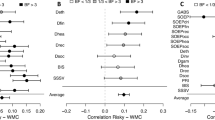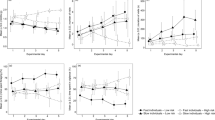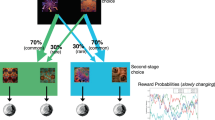Abstract
During adolescence and early adulthood, learning when to avoid threats and when to pursue rewards becomes crucial. Using a risky foraging task, we investigated individual differences in this dynamic across 781 individuals aged 14–24 years who were split into a hypothesis-generating discovery sample and a hold-out confirmation sample. Sex was the most important predictor of cautious behaviour and performance. Males earned one standard deviation (or 20%) more reward than females, collected more reward when there was little to lose and reduced foraging to the same level as females when potential losses became high. Other independent predictors of cautiousness and performance were self-reported daringness, IQ and self-reported cognitive complexity. We found no evidence for an impact of age or maturation. Thus, maleness, a high IQ or self-reported cognitive complexity, and self-reported daringness predicted greater success in risky foraging, possibly due to better exploitation of low-risk opportunities in high-risk environments.
This is a preview of subscription content, access via your institution
Access options
Access Nature and 54 other Nature Portfolio journals
Get Nature+, our best-value online-access subscription
$29.99 / 30 days
cancel any time
Subscribe to this journal
Receive 12 digital issues and online access to articles
$119.00 per year
only $9.92 per issue
Buy this article
- Purchase on Springer Link
- Instant access to full article PDF
Prices may be subject to local taxes which are calculated during checkout




Similar content being viewed by others
Data availability
Anonymized data are available from the Open Science Framework (https://osf.io/mnbfy/). Full data are available upon reasonable request from the corresponding author or from OpenNSPN@medschl.cam.ac.uk.
Code availability
All custom code used for the analysis is available from the Open Science Framework (https://osf.io/mnbfy/). After extracting task measures using MATLAB 2017b, all discovery analyses were performed in R 3.4.1 (www.r-project.org), using the following toolboxes: R.matlab version 3.6.1, abind 1.4-5, reshape2 1.4.3, nlme 3.1-131.1, lme4 1.1-15, lmerTest 2.0-36, nFactors 2.3.3 and sem 3.1-9. Confirmation and post-hoc analyses were performed in R 3.5.2, using the following toolboxes: R.matlab version 3.6.2, abind 1.4-5, reshape2 1.4.3, psych 1.8.12, lme4 1.1-21, lmerTest 3.1-0, sem 3.1-9, pracma 2.2.5, mediation 4.5.0, gvlma 1.0.0.3, DescTools 0.99.30 and corrplot 0.84.
References
Lima, S. L. & Dill, L. M. Behavioral decisions made under the risk of predation: a review and prospectus. Can. J. Zool. 68, 619–640 (1990).
Cook, C., Diamond, R., Hall, J., List, J. A. & Oyer, P. The Gender Earnings Gap in the Gig Economy: Evidence from Over a Million Rideshare Drivers (National Bureau of Economic Research, 2018).
Steinberg, L. Risk taking in adolescence: what changes, and why? Ann. NY Acad. Sci. 1021, 51–58 (2004).
Schwebel, D. C., Severson, J., Ball, K. K. & Rizzo, M. Individual difference factors in risky driving: the roles of anger/hostility, conscientiousness, and sensation-seeking. Accid. Anal. Prev. 38, 801–810 (2006).
Eaton, D. K. et al. Youth risk behavior surveillance—United States, 2007. MMWR Surveill. Summ. 57, 1–131 (2008).
Somerville, L. H. & Casey, B. J. Developmental neurobiology of cognitive control and motivational systems. Curr. Opin. Neurobiol. 20, 236–241 (2010).
Romer, D., Reyna, V. F. & Satterthwaite, T. D. Beyond stereotypes of adolescent risk taking: placing the adolescent brain in developmental context. Dev. Cogn. Neurosci. 27, 19–34 (2017).
Khurana, A., Romer, D., Betancourt, L. M. & Hurt, H. Modeling trajectories of sensation seeking and impulsivity dimensions from early to late adolescence: universal trends or distinct sub-groups? J. Youth Adolesc. 47, 1992–2005 (2018).
Van den Bos, W. & Hertwig, R. Adolescents display distinctive tolerance to ambiguity and to uncertainty during risky decision making. Sci. Rep. 7, 40962 (2017).
Frey, R., Pedroni, A., Mata, R., Rieskamp, J. & Hertwig, R. Risk preference shares the psychometric structure of major psychological traits. Sci. Adv. 3, e1701381 (2017).
Overman, W. H. et al. Performance on the IOWA card task by adolescents and adults. Neuropsychologia 42, 1838–1851 (2004).
Deakin, J., Aitken, M., Robbins, T. & Sahakian, B. J. Risk taking during decision-making in normal volunteers changes with age. J. Int. Neuropsychol. Soc. 10, 590–598 (2004).
Lauriola, M., Panno, A., Levin, I. P. & Lejuez, C. W. Individual differences in risky decision making: a meta-analysis of sensation seeking and impulsivity with the balloon analogue risk task. J. Behav. Decis. Making 27, 20–36 (2014).
Defoe, I. N., Dubas, J. S., Figner, B. & van Aken, M. A. A meta-analysis on age differences in risky decision making: adolescents versus children and adults. Psychol. Bull. 141, 48–84 (2015).
Bach, D. R., Hulme, O., Penny, W. D. & Dolan, R. J. The known unknowns: neural representation of second-order uncertainty, and ambiguity. J. Neurosci. 31, 4811–4820 (2011).
Bach, D. R. & Dolan, R. J. Knowing how much you don’t know: a neural organization of uncertainty estimates. Nat. Rev. Neurosci. 13, 572–586 (2012).
Korn, C. W. & Bach, D. R. Maintaining homeostasis by decision-making. PLoS Comput. Biol. 11, e1004301 (2015).
Korn, C. W. & Bach, D. R. Heuristic and optimal policy computations in the human brain during sequential decision-making. Nat. Commun. 9, 325 (2018).
Korn, C. W. & Bach, D. R. Minimizing threat via heuristic and optimal policies recruits hippocampus and medial prefrontal cortex. Nat. Hum. Behav. 3, 733–745 (2019).
Caraco, T. Energy budgets, risk and foraging preferences in dark-eyed juncos (Junco hyemalis). Behav. Ecol. Sociobiol. 8, 213–217 (1981).
Kolling, N., Behrens, T. E., Mars, R. B. & Rushworth, M. F. Neural mechanisms of foraging. Science 336, 95–98 (2012).
Khemka, S., Barnes, G., Dolan, R. J. & Bach, D. R. Dissecting the function of hippocampal oscillations in a human anxiety model. J. Neurosci. 37, 6869–6876 (2017).
Bach, D. R. et al. Human hippocampus arbitrates approach–avoidance conflict. Curr. Biol. 24, 541–547 (2014).
Bach, D. R., Korn, C. W., Vunder, J. & Bantel, A. Effect of valproate and pregabalin on human anxiety-like behaviour in a randomised controlled trial. Transl. Psychiatry 8, 157 (2018).
Korn, C. W. et al. Amygdala lesions reduce anxiety-like behavior in a human benzodiazepine-sensitive approach–avoidance conflict test. Biol. Psychiatry 82, 522–531 (2017).
Bach, D. R., Hoffmann, M., Finke, C., Hurlemann, R. & Ploner, C. J. Disentangling hippocampal and amygdala contribution to human anxiety-like behavior. J. Neurosci. 39, 8517–8526 (2019).
Mobbs, D. & Kim, J. J. Neuroethological studies of fear, anxiety, and risky decision-making in rodents and humans. Curr. Opin. Behav. Sci. 5, 8–15 (2015).
Kiddle, B. et al. Cohort Profile: the NSPN 2400 Cohort: a developmental sample supporting the Wellcome Trust NeuroScience in Psychiatry Network. Int. J. Epidemiol. 47, 18–19g (2018).
Yarkoni, T. & Westfall, J. Choosing prediction over explanation in psychology: lessons from machine learning. Perspect. Psychol. Sci. 12, 1100–1122 (2017).
Tingley, D., Yamamoto, T., Hirose, K., Keele, L. & Imai, K. Mediation: R package for causal mediation analysis. J. Stat. Softw. 59, 1–38 (2014).
Markowitz, H. Portfolio selection. J. Finance 7, 77–91 (1952).
Symmonds, M., Bossaerts, P. & Dolan, R. J. A behavioral and neural evaluation of prospective decision-making under risk. J. Neurosci. 30, 14380–14389 (2010).
Symmonds, M., Wright, N. D., Bach, D. R. & Dolan, R. J. Deconstructing risk: separable encoding of variance and skewness in the brain. Neuroimage 58, 1139–1149 (2011).
Byrnes, J. P., Miller, D. C. & Schafer, W. D. Gender differences in risk taking: a meta-analysis. Psychol. Bull. 125, 367–383 (1999).
Lewis, G. et al. Risk taking to obtain reward: gender differences and associations with emotional and depressive symptoms in a nationally representative cohort of UK adolescents. Preprint at BioRxiv https://www.biorxiv.org/content/10.1101/644450v1 (2019).
Van den Bos, R., Taris, R., Scheppink, B., de Haan, L. & Verster, J. C. Salivary cortisol and alpha-amylase levels during an assessment procedure correlate differently with risk-taking measures in male and female police recruits. Front. Behav. Neurosci. 7, 219 (2013).
Fisher, P. J. & Yao, R. Gender differences in financial risk tolerance. J. Econ. Psychol. 61, 191–202 (2017).
Stuart, K. UK gamers: more women play games than men, report finds. The Guardian https://www.theguardian.com/technology/2014/sep/17/women-video-games-iab (17 September 2014).
DeCamp, W. Who plays violent video games? An exploratory analysis of predictors of playing violent games. Pers. Indiv. Differ. 117, 260–266 (2017).
Green, C. S. & Bavelier, D. Action video game modifies visual selective attention. Nature 423, 534–537 (2003).
Dye, M. W., Green, C. S. & Bavelier, D. Increasing speed of processing with action video games. Curr. Dir. Psychol. Sci. 18, 321–326 (2009).
Sheynin, J. et al. Behaviourally inhibited temperament and female sex, two vulnerability factors for anxiety disorders, facilitate conditioned avoidance (also) in humans. Behav. Processes 103, 228–235 (2014).
Sheynin, J., Moustafa, A. A., Beck, K. D., Servatius, R. J. & Myers, C. E. Testing the role of reward and punishment sensitivity in avoidance behavior: a computational modeling approach. Behav. Brain Res. 283, 121–138 (2015).
Moutoussis, M. et al. Change, stability, and instability in the Pavlovian guidance of behaviour from adolescence to young adulthood. PLoS Comput. Biol. 14, e1006679 (2018).
Calhoon, G. G. & Tye, K. M. Resolving the neural circuits of anxiety. Nat. Neurosci. 18, 1394–1404 (2015).
Gray, J. A. & McNaughton, N. The Neuropsychology of Anxiety: an Enquiry Into the Functions of the Septohippocampal System (Oxford Univ. Press, 2000).
Kirlic, N., Young, J. & Aupperle, R. L. Animal to human translational paradigms relevant for approach avoidance conflict decision making. Behav. Res. Ther. 96, 14–29 (2017).
Biedermann, S. V. et al. An elevated plus-maze in mixed reality for studying human anxiety-related behavior. BMC Biol. 15, 125 (2017).
DeWall, C. N., Baumeister, R. F., Chester, D. S. & Bushman, B. J. How often does currently felt emotion predict social behavior and judgment? A meta-analytic test of two theories. Emot. Rev. 8, 136–143 (2015).
Bach, D. R. & Dayan, P. Algorithms for survival: a comparative perspective on emotions. Nat. Rev. Neurosci. 18, 311–319 (2017).
LeDoux, J. E. Semantics, surplus meaning, and the science of fear. Trends Cogn. Sci. 21, 303–306 (2017).
Barrett, L. F. The theory of constructed emotion: an active inference account of interoception and categorization. Soc. Cogn. Affect. Neurosci. 12, 1–23 (2016).
Rouault, M., Seow, T., Gillan, C. M. & Fleming, S. M. Psychiatric symptom dimensions are associated with dissociable shifts in metacognition but not task performance. Biol. Psychiatry 84, 443–451 (2018).
Harris, P. A. et al. Research Electronic Data Capture (REDCap)—a metadata-driven methodology and workflow process for providing translational research informatics support. J. Biomed. Inform. 42, 377–381 (2009).
Wechsler, D. Wechsler Abbreviated Scale of Intelligence. The Psychological Corporation (Harcourt Brace & Company, 1999).
Costello, E. J. & Angold, A. Scales to assess child and adolescent depression: checklists, screens, and nets. J. Am. Acad. Child Adolesc. Psychiatry 27, 726–737 (1988).
Reynolds, C. R. & Richmond, B. O. What I think and feel: a revised measure of children’s manifest anxiety. J. Abnorm. Child Psychol. 25, 15–20 (1997).
Rosenberg, M. Conceiving the Self (Basic Books, 1979).
Kessler, R. & Mroczek, D. Final Versions of Our Non-Specific Psychological Distress Scale [memo dated 10/3/94]. (Survey Research Center of the Institute for Social Research, University of Michigan, 1994).
Frick, P. H. & Hare, R. D. The Antisocial Process Screening Device (Multi-Health Systems, 2001).
Lahey, B. B., Rathouz, P. J., Applegate, B., Tackett, J. L. & Waldman, I. D. Psychometrics of a self-report version of the Child and Adolescent Dispositions Scale. J. Clin. Child Adolesc. Psychol. 39, 351–361 (2010).
Raine, A. The SPQ: a scale for the assessment of schizotypal personality based on DSM-III-R criteria. Schizophr. Bull. 17, 555–564 (1991).
Kimonis, E. R. et al. Assessing callous–unemotional traits in adolescent offenders: validation of the Inventory of Callous–Unemotional Traits. Int. J. Law Psychiatry 31, 241–252 (2008).
Patton, J. H., Stanford, M. S. & Barratt, E. S. Factor structure of the Barratt Impulsiveness Scale. J. Clin. Psychol. 51, 768–774 (1995).
Morey, R. D., Hoekstra, R., Rouder, J. N., Lee, M. D. & Wagenmakers, E. J. The fallacy of placing confidence in confidence intervals. Psychon. Bull. Rev. 23, 103–123 (2016).
Burnham, K. P. & Anderson, D. R. Multimodel inference—understanding AIC and BIC in model selection. Sociol. Methods Res. 33, 261–304 (2004).
Acknowledgements
We thank the NSPN management and research assistant teams. The cognitive experiments were realized using Cogent 2000 (developed by the Cogent 2000 team at the FIL and ICN) and Cogent Graphics (developed by J. Romaya at the Wellcome Department of Imaging Neuroscience). The Wellcome Trust funded the Neuroscience in Psychiatry Project (NSPN). All NSPN members (Supplementary Table 1) are supported by a Wellcome Strategic Award (095844/7/11/Z). D.R.B. is supported by funding from the European Research Council under the European Union’s Horizon 2020 research and innovation programme (grant agreement number ERC-2018 CoG-816564 ActionContraThreat). M.M. and D.R.B. receive support from the National Institute for Health Research (NIHR) UCLH Biomedical Research Centre. R.J.D. is supported by a Wellcome Investigator Award (098362/Z/12/Z). P. Fonagy (NSPN consortium; Supplementary Table 1) is in receipt of an NIHR Senior Investigator Award (NF-SI-0514-10157) and was in part supported by the NIHR Collaborations for Leadership in Applied Health Research and Care (CLAHRC) North Thames at Barts Health NHS Trust. The Max Planck UCL Centre for Computational Psychiatry and Ageing is a joint initiative of the Max Planck Society and UCL. The Wellcome Centre for Human Neuroimaging is funded by core funding from the Wellcome Trust (203147/Z/16/Z). The views expressed in this article are those of the authors and not necessarily those of the NHS, NIHR or Department of Health. The funders had no role in study design, data collection and analysis, decision to publish or preparation of the manuscript.
Author information
Authors and Affiliations
Consortia
Contributions
D.R.B., M.M., the NSPN consortium and R.J.D. contributed to the conception and design of this work. M.M., the NSPN consortium and R.J.D. contributed to acquisition of the data. D.R.B. and M.M. analysed the data. D.R.B., M.M., A.B. and R.J.D. contributed to interpretation of the data and to drafting and revising the manuscript.
Corresponding author
Ethics declarations
Competing interests
The authors declare no competing interests.
Additional information
Publisher’s note Springer Nature remains neutral with regard to jurisdictional claims in published maps and institutional affiliations.
Primary Handling Editor Anne-Marike Schiffer.
Extended data
Extended Data Fig. 1 Extraction of summary statistics from time-dependent variables.
Four summary statistics are extracted for each of 7 time-dependent task measures, and for their time-dependent weighted sum (example data). Blue: low threat probability; orange: high threat probability. Example data are averaged over the active/passive (ie. starting position) factor.
Extended Data Fig. 2 Association of individual task variables with sex.
Results from linear regressions fitted separately on discovery and confirmation sample. See supplementary table 2 for statistical tests of the individual relations. To confirm these associations collectively, we fitted a multiple logistic regression on the discovery data (registered hypothesis H1), which was confirmed. See Table 2 in main text for hypothesis summary and discovery/confirmation results. A multiple logistic regression across the entire sample weakly favoured a model with common regression weights over one with separate weights for discovery and confirmation sample (LBF = 2.8).
Extended Data Fig. 3 Association of individual task variables with CADS daringness.
Results from linear regressions fitted separately on discovery and confirmation sample. See supplementary table 2 for statistical tests of the individual relations. To confirm these associations collectively, we computed a multiple regression model on the discovery data (registered hypothesis H4), which was confirmed. See Table 2 in main text for hypothesis summary and discovery/confirmation results. A multiple logistic regression across the entire sample favoured a model with common regression weights over one with separate weights for discovery and confirmation sample (LBF = 3.2). For the association of CADS with intra-epoch trajectories shown in Fig. 3 and Supplementary Table 2, we computed a multiple regression model with these three measures on the discovery data (registered hypothesis H7), which was confirmed (see Table 2). A multiple logistic regression across the entire sample weakly favoured a model with common regression weights over one with separate weights for discovery and confirmation sample (LBF = 2.3).
Extended Data Fig. 4 Association of individual task variables with IQ and BIS cognitive complexity.
Results from linear regressions fitted separately on discovery and confirmation sample. See supplementary table 2 for statistical tests of the individual relations. To confirm the associations with IQ collectively, we computed a multiple regression model on the discovery data (registered hypothesis H3), which was confirmed. See Table 2 in main text for hypothesis summary and discovery/confirmation results. A multiple logistic regression across the entire sample weakly favoured a model with common regression weights over one with separate weights for discovery and confirmation sample (LBF = 2.5). For BIS cognitive complexity, the multiple regression model (registered hypothesis H6) was confirmed as well (see Table 2). A multiple logistic regression across the entire sample weakly favoured a model with common regression weights over one with separate weights for discovery and confirmation sample (LBF = 2.7).
Extended Data Fig. 5 Lottery (revealed economic preference) task.
The roulette task involved a choice between the sure amount (upper left) and a four-sector roulette, just complex enough to define an Expectation, Variance and Skewness over roulette outcomes. The square in the middle of the roulette indicated a timer to maintain a reasonable pace of trials.
Supplementary information
Supplementary Information
Supplementary Tables 1–4 and Supplementary Results 1–6.
Rights and permissions
About this article
Cite this article
Bach, D.R., Moutoussis, M., Bowler, A. et al. Predictors of risky foraging behaviour in healthy young people. Nat Hum Behav 4, 832–843 (2020). https://doi.org/10.1038/s41562-020-0867-0
Received:
Accepted:
Published:
Issue Date:
DOI: https://doi.org/10.1038/s41562-020-0867-0
This article is cited by
-
Self-reported childhood family adversity is linked to an attenuated gain of trust during adolescence
Nature Communications (2023)
-
Comparison of two reaction-time-based and one foraging-based behavioral approach-avoidance tasks in relation to interindividual differences and their reliability
Scientific Reports (2023)
-
Seeking Pleasure, Finding Trouble: Functions and Dysfunctions of Trait Sensation Seeking
Current Addiction Reports (2023)
-
The effects of hydrocortisone and yohimbine on human behavior in approach-avoidance conflicts
Psychopharmacology (2023)
-
Cross-species anxiety tests in psychiatry: pitfalls and promises
Molecular Psychiatry (2022)



